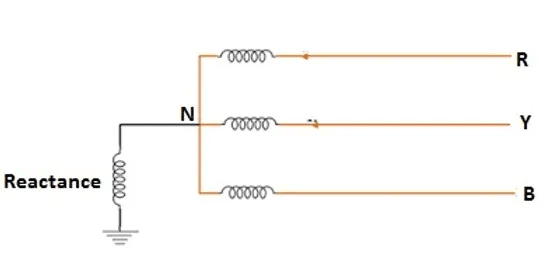Adding inductive reactance from a neutral point to the ground is called reactance grounding. The inductive reactance is called the reactor.

Using reactance it is possible to limit the three-phase fault current of in order of kA to a relatively low value in order of 200-800 ampere. Even after adding low reactance to neutral, it is not ensured that whether it is reactance grounding or not. The following criteria must be fulfilled to ensure it is reactance grounding.
- At the time of the fault, the ratio of zero sequence impedance to positive sequence impedance is greater than 3.
Xₒ/X1 > 3
- After the fault, the reactance of the system and the reactance added to neutral may have resonance during the fault. To avoid this, the ratio of zero sequence impedance to positive sequence impedance must be equal to or less than 3.
Xₒ/X1 ≤ 3
- During fault clearing, the ratio of zero sequence impedance to positive sequence impedance is greater than 3.
Xₒ/X1 > 3
In a synchronous generator, the ground fault currents are higher than the three-phase current at the terminals. The high fault current cause excessive heating in the generator winding. To limit the fault current low reactance in the neutral circuit is added,
In transmission and distribution systems, without directly connected rotating machines, the neutrals of the transformers are usually effectively grounded.
The phase-to-ground fault current should be in the range of 25% to 100% of the three-phase fault current. ground fault current of less than 25% of the three-phase current may cause damage due to transient overvoltages. Choose the value of reactance needed to limit the ground-fault current to the preferred amount.
The ratio is
- Xₒ/X1 = 10 when 25%
- Xₒ/X1 = 1 when 100%
- Xₒ/X1 = 3 when 60%
Limiting the ground-fault current to 60% of the three-phase fault current is the borderline between effective grounding and reactance grounding.
When installing a 100% reactor in a generator neutral, the system is not reactance grounded but effective grounded, by definition, and the maximum fault-current contribution of this generator to a line-to-ground fault anywhere in the system outside of the generator will be its three-phase fault current.
Cons of Reactive grounding
The inductance connected between the neutral and ground may resonate with the shunt capacitance to the ground under arcing ground fault conditions. Under this condition, it creates very high transient overvoltage in the electrical power system. This is similar to the phenomenon that happens with ungrounded systems. To avoid this, at least 60 % of the three-phase current must flow through the reactor. If the three-phase current is 20,000A, 6000 amperes current must flow through the reactor. Thus, very high current flow through the reactor to avoid the condition of transient overvoltage, and therefore reactance grounding is rarely used.